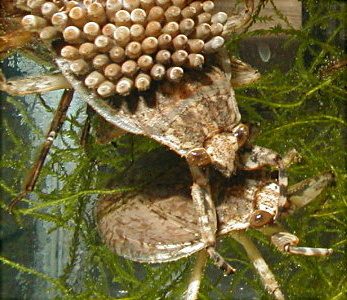 |
.
|
 |
. The Giant Water Bugs -- family Belostomatidae -- contains about two hundred species from around the world. They are in the Order Hemiptera or True Bugs. All Giant Water Bugs have paddle shaped rear and hind legs for swimming, raptorial front legs for catching prey, a flat oval-shaped body, and range in color from blackish-brown to yellowish-tan. Members of the Belostomatidae range in adult size from 15mm (3/5 inch) to 100mm (4 inches). The Ferocious Water Bug Abedus herberti is a medium/large member of this family and ranges from 30-45mm in length, the body is relatively wider than most of the other species in the family.
A.herberti can inflict slightly painful bites to humans but they are not aggressive and do not bite unless handled carelessly. Small nymphs usually can't bite even when handled carelessly. The bite is reported to include a minor poison like a bee sting and some digestive enzymes. Any person with severe allergies should be careful with or stay away from any biting animal. Water bug bites do not pass any diseases.
Ferocious Water Bugs begin life as eggs. Unlike many insects whose eggs are abandoned by the adults, A.herberti eggs are glued to the surface of the males tegmina (outer wings) and the adult males care for and protect the eggs until they hatch. Eggs removed from the males back do not hatch. There are many smaller species of Abedus in which males carry the eggs. Other large types of water bugs such as members of the genus Lethoceros glue eggs to emergent vegetation and adults tend to eat them but at the same time they do not survive without adult care. In captivity it is important not to have excessive emergent areas in the cage as crickets used as food will sometimes walk unnoticed on the males back and eat the eggs.
Tiny nymphs, which look similar to adults, hatch in three weeks. The young eat well and will molt five times in reaching adulthood. Nymphs molt (shed their old skins) while in the water and they need something to hang on to. A percentage of nymphs can die during molts which is directly affected by the surfaces available. Styrofoam pieces and rocks do not work well. Sticks placed in the water are adequate. The best surface is provided by pieces of the aquatic plant Java moss. Pieces of dead sphagnum moss might work nearly as well as Java moss. Tiny nymphs should be provided a lot of Java moss to create shallow spots because deep water is deadly.
Hatchlings have voracious appetites. Nymphs will feed on tiny aquatic arthropods such as Daphnia, small fish such as baby guppies, tubifex worms, and small snails. Nymphs will also feed on unrealistically large land insects which are dropped into the water. Adult crickets and mealworms will be fed on despite being as much as 50 times the mass of a hatchling. Frozen crickets are also accepted. The only drawback to feeding large insects to the nymphs is that remains should be removed after feeding so as not to foul the water.
Adult A.herberti are kept together as they do not kill one another unless severely starved (months). Although adults do not eat one another, adults will eat nymphs and nymphs will feed on one another. Nymphs must be reared separately and are usually kept in disposable cups with a few inches of water in the bottom-- they can not climb smooth surfaces. Nymphs which have recently become adults have very soft shells and may be killed. Two weeks should be allowed for the new exoskeleton to harden before new adults are placed with others.
A.herberti can be kept in any aquarium or watertight container and do not seem to be concerned whether kept in a few inches or a few feet of water. Planted water /terrariums make beautiful cages but a bucket with a few inches of water works just as well. Although keeping them with tropical fish is ill-advised for the aquarist , the interaction between the fish and Ferocious Water Bugs can be fun to watch. There are two major considerations when choosing housing: 1. As Abedus can fly a lid is necessary. 2. Abedus cannot climb smooth sided containers but they easily climb tubing and cords so these must be covered around.
Water quality is not as great a concern as with most aquatic animals but still must be paid some attention. Hardness, pH, and contaminants seldom, if ever, affect the Ferocious Water Bug. Filtration is unnecessary. Fouled water can be poured out and replaced straight from the tap without causing any ill effects. Although nymphs and adults take air from the surface, severely fouled water will use up all the oxygen in the air stored under the abdomen of the animal and much time will be spent constantly replenishing the air supply. Conversely, in clean, well aerated water long periods are spent without coming to the surface. Adults tend to survive the dirtiest of water but nymphs are more sensitive and nasty water can kill them. Also, fouled water often has a greasy film which can prevent nymphs from breaking the surface tension and getting new air during the molting process; this can drown them.
The Ferocious Water Bug is among the neatest of the insect pets. The ease of care and breeding of this animal promises to keep it in the hobby. Hopefully this article will not only help those interested in this species but also inspire new keepers to try this great bug.
 |
 |
 |